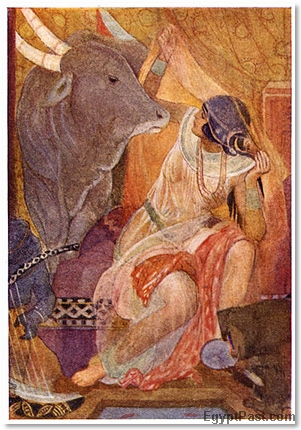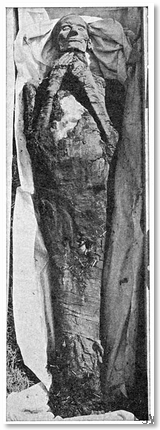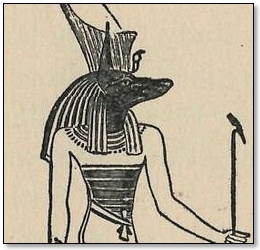EGYPTIAN RELIGION

A mythological scene - the god assumes the form of a bull
No satisfactory treatment of this subject has appeared, though it was one of the first to awaken interest. The names of the gods of the Egyptian pantheon are well known and their general characteristics are sufficiently defined, but the gradations between them and the conceptions which gave them force are obscured, not only by the most curious inconsistencies, but by the fog of a mythology which is for the most part unknown to us.
Religious conceptions existed during all periods, but never a religion in any true sense. It is plain enough that the differences in religious belief and practice corresponded to the primitive condition of the land, each district having its chief object of veneration. It was a condition of HENOTHEISM (q. v.) out of which, in consequence of the closer contact produced by the union of the nomoi under a central government, there grew up a system of national polytheism, in which the principal god of the capital gained pre-eminence.

An Egyptian Mummy
The original deities were objects of nature, but their development was various in the different nomoi. Only at a later date did gods appear who represented abstract or cosmogonical ideas. When intimate association occurred there was a resultant confusion of attributes and names. The hegemony of the god of the capital contained in itself the motives of monotheism, but there is no indication that monotheism was the original form of the Egyptian religion, in spite of such phrases as "the only god," and the like. When carefully examined these expressions are found to refer to the deity held in special reverence in a particular locality, the "city god" or the leader of the local triad or ennead. Endowed temples and independent priests of separate deities prove that a determined resistance was made to any attempt to introduce monotheism, such as is actually seen in the case of Amenophis IV. See KHUNATEN.
Local Gods.—Ptah was the god of Memphis; Neith, the warlike goddess of Libyan Sais; Khnumu (Chnum) of Elephantine was the deity of the cataract regions; while Nechebt was the protecting goddess of the south in general. Min (Greek, Pan) was the desert god. Osiris of Abydos supplanted the earlier deity. Amon of Thebes, Anubis of Lycopolis, Turn (Atom) "Lord of Heliopolis," Bast of Bubastis, Sebek of the Fayum, Hathor of Denderah, Horus of Edfu, Thoth of Hermopolis, Mont of Hermonthis -- these suffice as examples of deities which enjoyed special local homage.

A Dog Headed Egyptian God
Animal Forms. -- The forms which many of the deities assume are grotesque in the extreme. It may be a human or animal shape, but more frequently it is a mixture of the two, the human trunk being surmounted by an animal head. Thus Ptah appears as the Apis-Bull, Hapi, Amon, and Khnumu (Chnum) as rams, Sebek as a crocodile-headed man, Nechebt as a serpent, Mut as a vulture, Anubis as a jackal-headed man, Bast as a cat-headed woman, Sechmet and Tefnut as lion-headed, Hathor as a cow, Horus as a hawk, or a hawk-headed man, Thoth as an ibis. The Phoenix is possibly derived from Benu of Heliopolis, which appears as a heron.
See also: Egyptian Gods
pyramids Egypt Mummies Search Engines Link Report
Egyptian Cities | Egyptian Education | Ancient Egypt | egyptian clothing | Egyptian Houses | The Egyptians | Egyptian Family Life | Egypt and its Neighbours | Government in Ancient Egypt | Egyptian History | Military | Organization of Ancient Egypt | Recreation | Egyptian Religion | Pyramids | About | Privacy Policy | Site News | Site Map
EgyptPast.com - Facts and Information About the History of Ancient Egypt
-